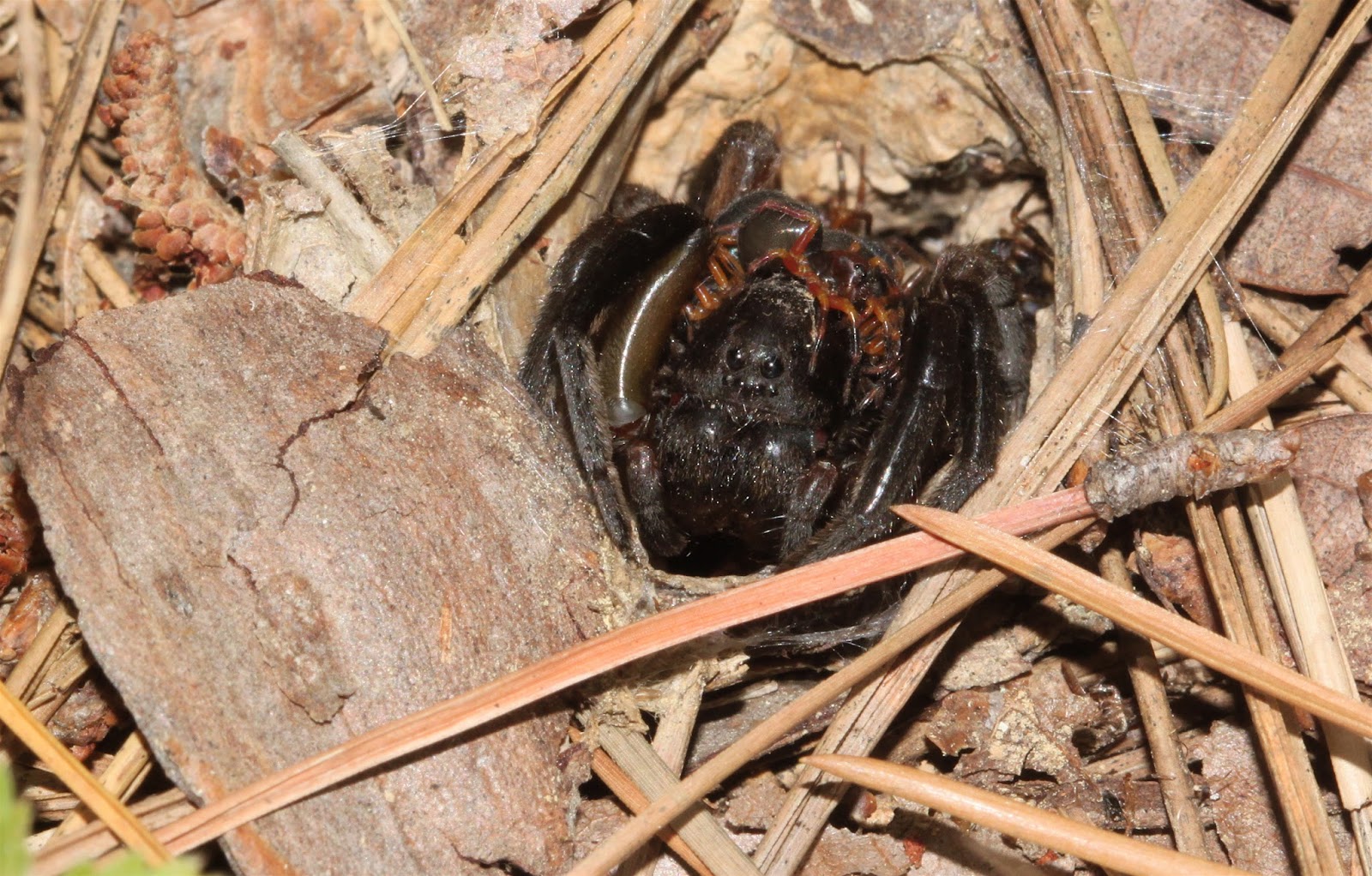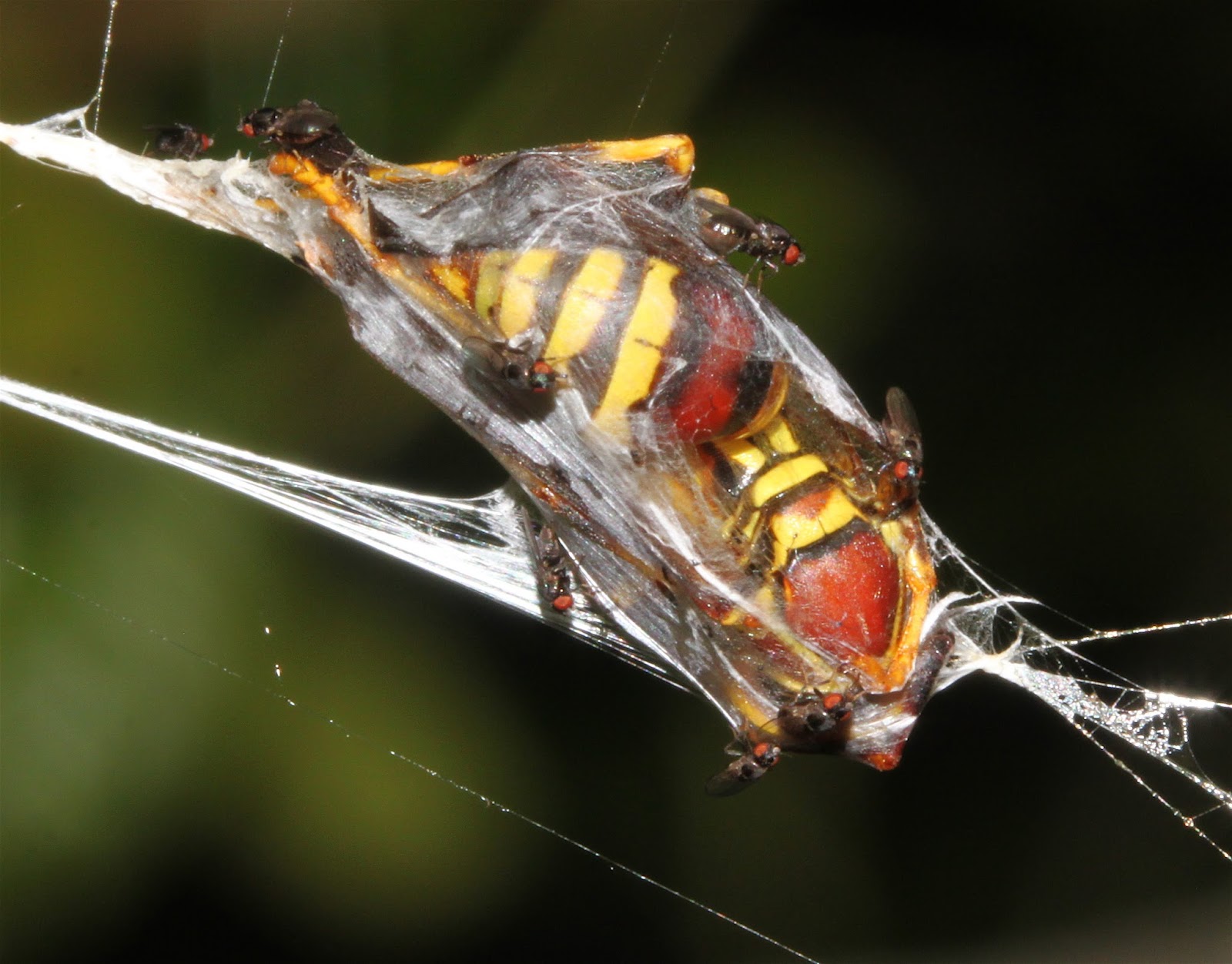Well, we had the fun of discovering G. missouriensis when no Geolycosa species had previously been found in Arkansas. Now I think we might have found a second species. I know, we are new spiderers, and we might be at that stage new birdwatchers are, when they try to turn every unfamiliar species into some great rarity. Here is what happened. When we were at Scatter Creek in Green County in May (as I reported in my post of that time) we found G. missouriensis by the score. In August we revisited the area, and found that they were nearly gone, only a few small ones (pencil-size or smaller burrows) still present in the quarries where they had been densest.
That was a disappointment, but compensated for by what we found instead. First we found a large burrow with what appeared to be a high turret, made on one side by a straightened up leaf, but rather trampled down on the other. There was movement near the surface, which we saw with our binoculars was caused by swarming baby spiders.
We sat quietly and waited the usual length of time for the owner of the burrow to rise up.
If you remember, missouriensis had yellow and black legs, and gray patches over the carapace and abdomen. This spider was just plain black, or at least all that we could see (its back was mostly covered by its babies). Missouriensis (this was one of its field marks) had yellow hairs covering the chelicerae (the big features below the eyes that cover the fangs). This spider had black hair. Now, of the half dozen species of Geolycosa in this country, only missouriensis has the yellow hair, and of those non-yellow-haired species there was only one that seemed, from a geographical standpoint, at all possible in Arkansas, and that was G. turricola, named, I presumed, for the very tall turret it put around its burrow. Did the sort of partial broken-down turret on this spider count as a very big turret?
Cheryl had spotted this one, and after we had wandered down towards the area where previously there had been the most Geolycosid activity, she also found the second one, a tall turret (over one centimeter high) that there was no doubt about.
The spider, when it rose up, was another large dark one (not as black as the first) with some perhaps graying on the chelicerae, but nothing that could be called yellow. The underside of the femora (the first long joint of the legs), was yellow. We would have to read up on legs to see if that was significant. Anyway, we had two characters of turricola: high turret, and no yellow on chelicerae.
We went home and I did some more reading. The first thing I found was, the marking on the first two pairs of legs (called, in spider descriptese, I and II) was indeed significant. This will be tedious to explain, and will require some terminology.
Here is some other spider that happens to have its legs in a convenient position. Reading from right to left, the long joint on the right is the femur, the next knee-like short joint is the patella, followed, heading left, by the tibia, metatarsus, and tarsus, or foot. It's the knee-like patella that is critical.
According to Bradley (Common Spiders of North America), on missouriensis "the bases of the front two pairs of legs [in this case, the femora and patelli] are light below....The tibia, metatarsi, and tarsi of these legs are dark below." On turricola "the undersides of the patellae, tibiae, metatarsi, and tarsi of legs I and II are black." In other words, the patella is the swing vote: light underneath for missouriensis, dark underneath for turricola.
The next day hop in the car and drive all the way back up. That's the easy part. The hard part is trying to get a picture of the underside of the legs of a rather shy spider you are more or less looking down on because it is down inside a hole in the ground.
Here's one attempt with the first spider:
The right front femur is showing a side view, with the dark upperside and pale underside. The patella is the next joint, and it is not easy to see exactly what angle we are getting on it, or how far it extends down before we are looking at the tibia, but there is no obvious lighter color to be seen, so it is quite possible that the patella is dark (the turricola pattern).
Here is another try at this spider.
Here we seem to have a pretty good side view from the patella on, and everything seems to be dark on the underside (again, the turricola pattern).
We then went down to the second spider and got this shot:
The angle of the legs is a little bit confusing. The spider's left front femur is going straight up in the air, showing its pale underside. The patella and tibia, showing the black upperside, then fold sharply back down, and the last two segments of the leg fold under the body. The second leg is angled back, and is out of sight behind the body except for just the tip of the pale underside of the femur poking up (above the eyes). The leg then bends to the right showing the patella and tibia from side view (the rest of the leg is then concealed behind the front leg). The side view shows patella and tibia undersides to be black (the turricola pattern).
So, we have absence of yellow on the chelicerae, a high turret on the burrow, and dark undersides to the patelli, the three characters that separate turricola from missouriensis. Here, for the sake of comparison, is a picture of missouriensis:
Here you see pale underside to patella (pale upperside as well), yellow hair covering chelicerae, no turret but sand sort of woven together around edge of burrow.
But just when you think you have it nailed down, you go back and reread the descriptions, and you begin hearing the weasel words. Missouriensis "often" has yellow hair on the chelicerae, it "sometimes" makes turrets. In other words, nothing is one hundred percent. (Maybe the leg color is dependable?) This is our first season with these spiders. For all we know, they darken with age. The more technical studies say you can only certainly identify them by careful inspection of the genitalia. But I'm a field man, my pleasure is in trying to identify species through binoculars or photographs without disturbing them.
On a less frustrating note: On an earlier post I showed The Laugher caterpillar wrapping itself up in an oak leaf and making its cocoon, and I said with luck we would see it next spring as a moth. In fact they turn out to have two generations a year, and within two weeks ours had hatched out and we found it on the bathroom floor where we photographed it, then turned it loose.






































